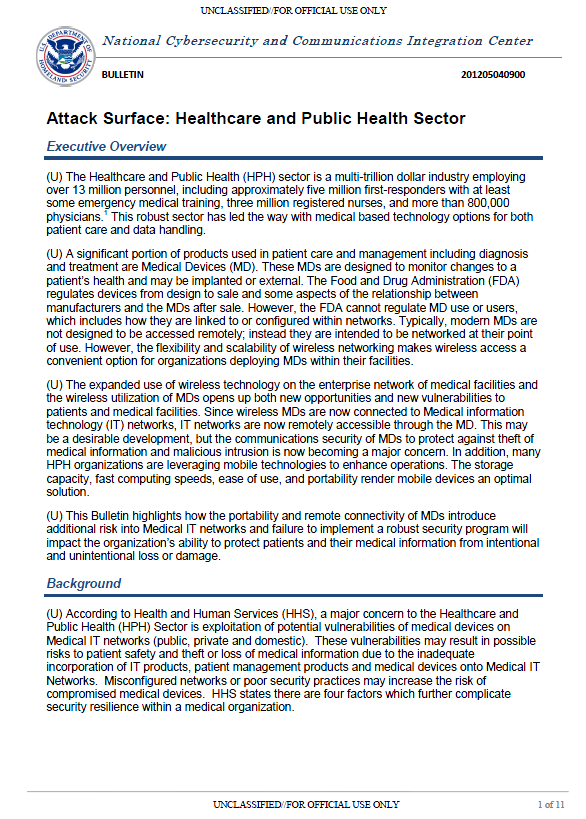National Cybersecurity and Communications Integration Center Bulletin
- 10 pages
- For Official Use Only
- May 4, 2012
(U) The Healthcare and Public Health (HPH) sector is a multi-trillion dollar industry employing over 13 million personnel, including approximately five million first-responders with at least some emergency medical training, three million registered nurses, and more than 800,000 physicians.
(U) A significant portion of products used in patient care and management including diagnosis and treatment are Medical Devices (MD). These MDs are designed to monitor changes to a patient’s health and may be implanted or external. The Food and Drug Administration (FDA) regulates devices from design to sale and some aspects of the relationship between manufacturers and the MDs after sale. However, the FDA cannot regulate MD use or users, which includes how they are linked to or configured within networks. Typically, modern MDs are not designed to be accessed remotely; instead they are intended to be networked at their point of use. However, the flexibility and scalability of wireless networking makes wireless access a convenient option for organizations deploying MDs within their facilities. This robust sector has led the way with medical based technology options for both patient care and data handling.
(U) The expanded use of wireless technology on the enterprise network of medical facilities and the wireless utilization of MDs opens up both new opportunities and new vulnerabilities to patients and medical facilities. Since wireless MDs are now connected to Medical information technology (IT) networks, IT networks are now remotely accessible through the MD. This may be a desirable development, but the communications security of MDs to protect against theft of medical information and malicious intrusion is now becoming a major concern. In addition, many HPH organizations are leveraging mobile technologies to enhance operations. The storage capacity, fast computing speeds, ease of use, and portability render mobile devices an optimal solution.
(U) This Bulletin highlights how the portability and remote connectivity of MDs introduce additional risk into Medical IT networks and failure to implement a robust security program will impact the organization’s ability to protect patients and their medical information from intentional and unintentional loss or damage.
…
(U) According to Health and Human Services (HHS), a major concern to the Healthcare and Public Health (HPH) Sector is exploitation of potential vulnerabilities of medical devices on Medical IT networks (public, private and domestic). These vulnerabilities may result in possible risks to patient safety and theft or loss of medical information due to the inadequate incorporation of IT products, patient management products and medical devices onto Medical IT Networks. Misconfigured networks or poor security practices may increase the risk of compromised medical devices. HHS states there are four factors which further complicate security resilience within a medical organization.
1. (U) There are legacy medical devices deployed prior to enactment of the Medical Device Law in 1976, that are still in use today.
2. (U) Many newer devices have undergone rigorous FDA testing procedures and come equipped with design features which facilitate their safe incorporation onto Medical IT networks. However, these secure design features may not be implemented during the deployment phase due to complexity of the technology or the lack of knowledge about the capabilities. Because the technology is so new, there may not be an authoritative understanding of how to properly secure it, leaving open the possibilities for exploitation through zero-day vulnerabilities or insecure deployment configurations. In addition, new or robust features, such as custom applications, may also mean an increased amount of third party code development which may create vulnerabilities, if not evaluated properly. Prior to enactment of the law, the FDA required minimal testing before placing on the market. It is challenging to localize and mitigate threats within this group of legacy equipment.
3. (U) In an era of budgetary restraints, healthcare facilities frequently prioritize more traditional programs and operational considerations over network security.
4. (U) Because these medical devices may contain sensitive or privacy information, system owners may be reluctant to allow manufactures access for upgrades or updates. Failure to install updates lays a foundation for increasingly ineffective threat mitigation as time passes.
…
(U) Implantable Medical Devices (IMD): Some medical computing devices are designed to be implanted within the body to collect, store, analyze and then act on large amounts of information. These IMDs have incorporated network communications capabilities to increase their usefulness. Legacy implanted medical devices still in use today were manufactured when security was not yet a priority. Some of these devices have older proprietary operating systems that are not vulnerable to common malware and so are not supported by newer antivirus software. However, many are vulnerable to cyber attacks by a malicious actor who can take advantage of routine software update capabilities to gain access and, thereafter, manipulate the implant.
(U) During an August 2011 Black Hat conference, a security researcher demonstrated how an outside actor can shut off or alter the settings of an insulin pump without the user’s knowledge. The demonstration was given to show the audience that the pump’s cyber vulnerabilities could lead to severe consequences. The researcher that provided the demonstration is a diabetic and personally aware of the implications of this activity. The researcher also found that a malicious actor can eavesdrop on a continuous glucose monitor’s (CGM) transmission by using an oscilloscope, but device settings could not be reprogrammed. The researcher acknowledged that he was not able to completely assume remote control or modify the programming of the CGM, but he was able to disrupt and jam the device.

